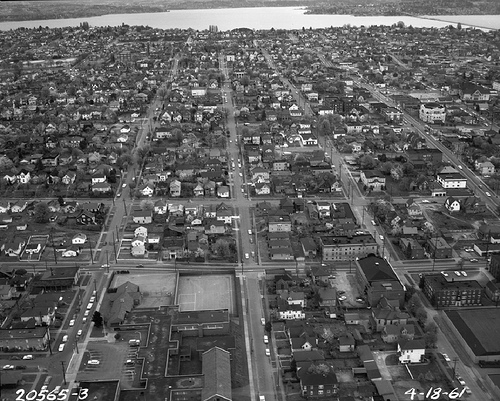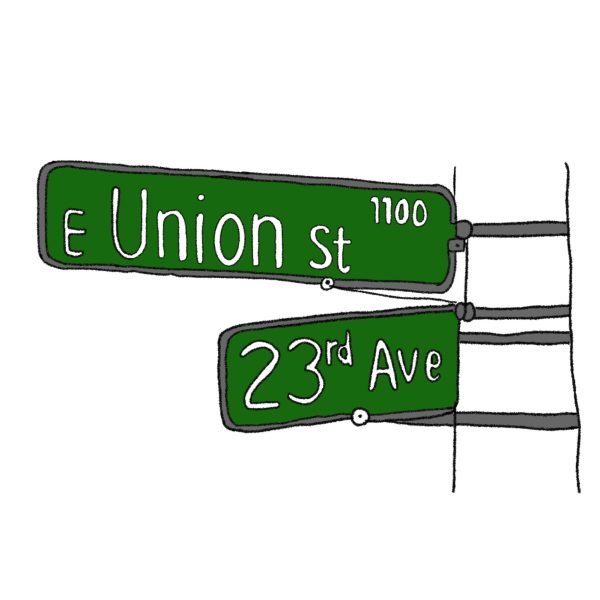History of the Central District

Central District 1961
History of Redlining by Hailey Gray
The Central District (C.D.) has a history rooted deeply in a plethora of cultures and social classes. Throughout the years, the C.D. has been home to Jewish Americans in the early 1900s, Japanese Americans around the 1930s, Black and African Americans people in the 1970s, and majority whites in the development of the 21st century. Each demographic change in the C.D., marks a change of wealth, prosperity, economic development, and segregation. Ultimately, inhabitants of Seattle have experience how segregation and systematic oppression not only shaped our nation, but our neighborhoods as well.
Despite the variety of races and ethnicity in the C.D., the neighborhood is known for being the home to many Black and African American people. In the 1970s, the C.D. was around 80% Black, but now is around 20% or less. The drop of the Black population was no accident; this racial change was executed through gentrification. However, segregation systematically created by the government was the spark to displacing people of color to begin with.
Redlining was a legal form of segregation that refused banking or home loans on the basis of race or ethnic makeup. This government act forced people of color into ghettos, by denying rights to move into well developed and wealthy suburbs. Additionally, disproportionately high rents and mortgages were given to people of color, in order to prevent them from moving into certain neighborhoods, and allowing them to be stuck into a cycle of poverty that lingers in modern day. Placing people of color in less developed urban areas, limited access to education, worse housing prices, and fewer resources, puts already disenfranchised groups at a systematic disadvantage.
Redlining, which was sparked by the racism and jealousy of whites, allowed for the placement of whites on top of society’s racial hierarchy, at the expense of people of color. The crush of people of color by the feet of white’s internalized racial superiority is faced in various urban areas, and Seattle is no exception.
Despite Seattle appearing progressive in terms of those it welcomes, in actuality, there was a long term fight for equality that many marginalized groups continue to struggle for. The C.D. used to be the home for those ostracized on the basis of race. Garfield was at the center of the Seattle’s redlining, making our neighborhood predominately Black in the late 1900s. However this began to change as people of color were no longer forced into areas, but rather pushed out due to gentrification, a process that renovates low-income urban areas to appeal to wealthier, affluent residents. The irony of this process falls under that fact that people of color are now uprooted from the areas they typically were forced into.
Both events are important events to the development of the C.D.’s history and to the history of Black and African American people in the U.S.
Secure the Bag! by Amari Garret
For hundreds of years, the advancement of African-Americans in the world has been slowed by policies and socioeconomic barriers that work to prevent their economic development. The economic stability of a group directly affects its ability to advance in society; and that is why it is important to take a look at the challenges that African-Americans face in that regard, and how those challenges can be overcome. The two greatest factors preventing our economic advancement are lack of ownership and access to good education.But how do African-Americans have a lack of ownership when they have an estimated collective of 1.1 trillion dollars in spending, and can afford to purchase things like like cars, clothes, homes, and even their own businesses? Well, when I talk about ownership, I’m referring to that which allows for the development of communities that are subject to being displaced by gentrification and other processes that cause African-Americans to lose their businesses and the little bit of ownership that they do have.
Whoa, whoa, whoa! Are you implying that in order to aid the economic development of African-Americans we need to stop gentrification?! Gentrification is inevitable. It just happens and you can’t really do anything about it, right. Wrong. Gentrification can be
stopped and the solution is simple–African-Americans need to own land. In 1999, African-Americans own about 2% of the land in America compared to the 96% that white Americans own. This disparity has a significant impact on African-Americans’ ability to progress, because it makes them susceptible to displacement.
A perfect example of this is the Central District of Seattle, in which the population of African-Americans has decreased tremendously over the past couple decades. To remedy this, long-time resident and community activist Wyking Garrett has been working to increase African-American ownership in the Central District. His largest project, Midtown Plaza, which encompasses the entire block.





